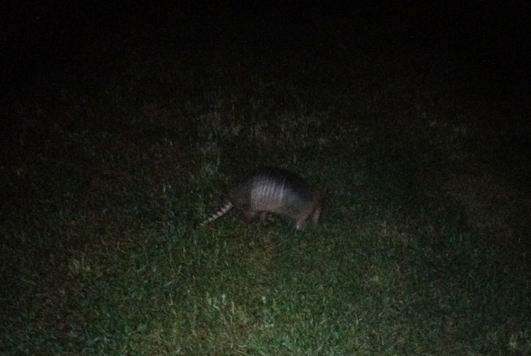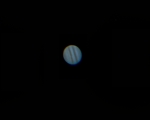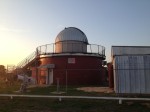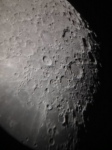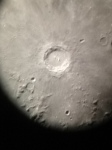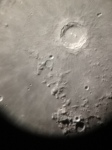The SBAS held our monthly meeting last night at LSU-S, during which we discussed a multitude of business-related topics, mostly about our budget, but the highlight of the meeting was a presentation given by one of our members and one of my good friends, Joey Matheson. He had been waiting for the opportunity to purchase an Observa-Dome dome in Natchitoches located at the high school. It went to auction recently and he snagged it at a heck of a bargain. There has been a 14″ scope inside of this thing and now, it’s his…and ours.
We are planning on transporting it (somehow) to our main observing site and while Joey will still own the dome, it’ll be there for club use. I can’t wait to give it a try.
We also discussed the possibility of fixing a C14 that has some focus issues, but they want to buy an expensive Hotech collimating device to get it back up and running. From what I understand, it was giving us a double image, in addition to other focusing issues. Imagine having a C14 at our disposal. The SBAS is on an up swing, assuming we can raise some much needed cash to keep us afloat.
After the meeting ended, I drove on out to the Worley under an almost full moon to do some observing. After setting up, I discovered I had placed my tarp near some rabbit droppings, so I had to remember that for the rest of the night so as to not step in it in the dark. I also had an armadillo pay me a quick visit before I packed up and left.
I leveled the scope, got aligned with Deneb, checked my alignment with Polaris and a few other objects, and set out to mess around with whatever the sky could offer. I also set up my binoculars on the tripod for some quick viewing. Not long after that, our club president and another member showed up to do some observing too.
Observing log:
Saturn: 150x and 300x (8mm/2x). Really crisp. Cassini was easy. Additional A/B ring detail (gradient). Surface detail. Three moons. I should’ve recorded video for stacking.
Cat’s Eye Nebula: Fleeting view of central star with direct vision. Slight slanting of its edges. 150x and 300x. Found with setting circles.
Moon: Aristarchus. Schroter’s Valley. Reiner Crater & Gamma. 25mm and 8mm with variable polarizer.
Doubles: Split Mizar and Albireo with binos. Split Izar at 150x in 8mm TMB.
Dumbbell: Viewed for fun to see how bad moonlight could kill it. Big smudge. No arching. No filter required. Didn’t try with a filter. Surprising, but not unexpected.
I could barely see the Eastern Veil with an OIII filter when it was closer to the Zenith. Prior to that, it was not visible at all.
I found two Caldwell open clusters (see below). Hunted for a couple Caldwell Cassiopeia galaxies (NGC147, NGC185), but couldn’t visualize them. Identified the location. Couldn’t overcome the moonlight. Same with a Caldwell nebula in Corona Australis. Right location. No visual confirmation.I also tried searching for NGC40 again, but I still could not see any signs of a planetary nebula anywhere in that field of view.
Found M31 in binos, then in 8×40 finder, then in 32mm eyepiece. M31/M32 were easy. M110 was barely visible with my skyglow LP filter.
Caldwell Objects:
NGC7243/Caldwell 16: Open cluster in Lacerta
12:35am. 48.6° az, 52.8° alt
Found by starhopping straight up from 4 Lacerta. Obvious cluster, despite being located in a very rich field. Cluster itself was narrow at top and widened out with a noticeable gap between two patches of stars within the cluster. The smaller patch had six or seven prominent stars shaped in a pentagon-like formation. The bottom larger half had 10-12 prominent stars with many more faint stars scattered in between. When viewed together, the cluster resembled a snail. Observed in a fairly moonlit sky. Viewed in 32mm ep (37.5x).
I will revisit this cluster because Struve 2890, a 9th mag double star, sits in the middle of the cluster. (It pays to review the SkySafari description ahead of time. Obviously, I did not do this prior to observing tonight.)
NGC6885/Caldwell 37: Open cluster in Vulpecula.
12:52am. 122.8° az, 79.6° alt
Difficult to hone in on because it was near the Zenith. Used Albireo as a jump point and navigated down. Obvious open cluster in 32mm ep against background stars. Located next to another cluster, NGC6882. There was a clear gap between the two clusters, a very apparent dark patch. 6882 was essentially three visible stars with the brightest one in the middle. C37 was above it in the eyepiece. C37 resembled a broad X without a star in the center. Imagine the Under Armour clothing X logo. The brightest of the six visible stars was on the right side of the field (20 Vulpecula). There were four stars on the left and three on the right. The other stars around it were apparently also part of the cluster, so all of C37 resembled a W or an M, depending on how you view it.
I hope to knock out NGC40 soon, but I’m mainly gunning for a better view of IC342/C5.

